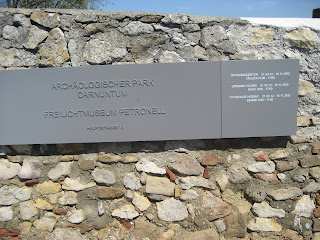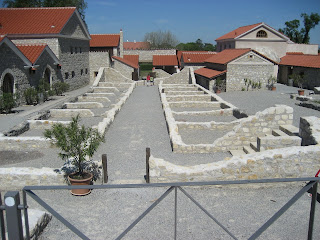Carnuntum is located approximately halfway between Vienna and Bratislava. The Austrian capital is about
The Romans established this town on the southern bank of the Danube, which at this point flows from west to east. Later the river turns to the right, and when it comes to Aquincum (Budapest), it flows from north to south. For many years this river was the northern and eastern border of the Roman Empire in Europe.
At first, Carnuntum was only a military base, but soon a civilian town grew up west of the military base. As the town grew, it became a long and narrow stripe along the southern bank of the River. From east to west it was ca. five km long, from north to south it was ca. one km wide.
An important reason for the growth of the town was its strategic location: the so-called amber route, that ran from the Baltic Sea in the north to Italy in the south, crossed the Roman frontier in this very place. From Carnuntum the route continued south through Scarbantia (Sopron) and Savaria (Szombathely) in present-day Hungary. The route ended in Aquileia, near the coast of the Adriatic Sea.
Carnuntum was a town in the Roman province of Pannonia. Around AD 100, during the reign of Trajan, the province was divided into two areas: Carnuntum became the capital of Pannonia Superior, while Aquincum became the capital of Pannonia Inferior.
Today, most of the ancient city has disappeared, but there are still some remains. If you wish to see some traces of the ancient town, there are five sites to visit:
Three sites are located in the west, in the village of Petronell-Carnuntum:
A monumental arch (Heidentor), the civilian amphitheatre and the new open-air museum, which opened in 2008. The new museum includes three ancient Roman buildings which are rebuilt in full size (a house, a villa and a bath house).
Two sites are located in the east, in the village of Bad Deutsch-Altenburg:
The military amphitheatre and the old museum, which opened in 1904. The central monument in the old museum is a relief from a mithraeum that shows Mithras killing a bull.
In antiquity this relief was painted in bright colours, but today the colours have virtually disappeared. To restore the original effect, the museum has installed a special laser system, which can project different colours on different parts of the relief. The light turns on and off automatically with short intervals. If you stand in front of the monument for a few minutes, you can see it both with and without colours.
All five sites managed by APC - Archäologischer Park Carnuntum - which has published a book about the ancient Roman town. The book describes the five sites (with emphasis on the new open-air museum with the three reconstructed buildings). At the same time, it serves as a guide to the five sites along the southern bank of the Danube River. The text is illustrated with photos, drawings and maps. All illustrations are in colour.
The book is bilingual. The text is in German and in English.
The German title is Carnuntum: Wiedergeborene Stadt der Kaiser, while the English title is Carnuntum: Reborn City of Emperors.
Why is Carnuntum described as an imperial city? For several reasons. Three Roman emperors met here in November 308: Diocletian, Galerius and Maximian came here to decide who should have a seat on the new tetrachy (a government of four emperors). Their decision was as follows: Galerius and Maximinus would be the emperors in the east, while Licinius and Constantine would be the emperors in the west.
Diocletian had abdicated in 305 (at the insistence of Galerius), but he returned for a short while for the summit of 308. Maximian had also abdicated in 305 (at the insistence of Diocletian), but he soon regretted this decision. He tried to get his old job back, but failed. Galerius had been a junior emperor (Caesar) since 293 and a senior emperor (Augustus) since 305.
Long before the summit of 308 took place, other emperors visited this province: Marcus Aurelius (161-180) stayed here for several years while he led a protracted war against some of the Roman enemies on the other side of the Danube. Lucius Septimius Severus, who was born in Leptis Magna (in Libya) in 145, was proclaimed emperor by his soldiers in 193, while he was governor of this province. He was emperor until 211.
Getting
there
Carnuntum is in the countryside. If you have your own car, there is no problem
with transport. If you do not have your own car, you can still get there. From
Vienna, take a local train (S-7) to Petronell-Carnuntum. The journey takes ca. 55 minutes. From the station you
can walk to the monumental arch, the civilian amphitheatre, and the new open-air museum. From
Petronell-Carnuntum, take the train to the next station, Bad Deutsch-Altenburg.
The journey takes less than five minutes. From the station you can walk to the old museum and the military amphitheatre.
Please
note: you need a whole day for this project. If you take the train, you should know
that it runs every hour on weekdays (Monday to Friday), but only every two hours during
the weekend (Saturday and Sunday).
If you are not in a hurry, you may wish to spend a few days in this area. In Petronell-Carnuntum you can stay in a three-star hotel which is named after a Roman emperor: Hotel Marc Aurel.
Carnuntum is definitely worth a visit, and the bilingual book published by APC provides a brief but useful introduction to this place.
If you are not in a hurry, you may wish to spend a few days in this area. In Petronell-Carnuntum you can stay in a three-star hotel which is named after a Roman emperor: Hotel Marc Aurel.
Carnuntum is definitely worth a visit, and the bilingual book published by APC provides a brief but useful introduction to this place.
* * *
Archaeological Park
Carnuntum,
Carnuntum - Widergeborene Stadt der Kaiser,
Carnuntum - Reborn City of Emperors,
no date, probably 2010, 26 pages
Carnuntum - Widergeborene Stadt der Kaiser,
Carnuntum - Reborn City of Emperors,
no date, probably 2010, 26 pages
* * *
The train station in Petronell-Carnuntum.
Turn left to visit the monumental gate.
From the gate you can continue north to the new museum.
Continue straight on from here, if you wish to pass through the modern village.
Turn left to visit the new open-air museum which is within walking distance.
Turn right to go to Bad Deutsch-Altenburg, but only if you are driving.
You do not want to walk to Bad Deutsch-Altenburg!
This hotel is named after a famous Roman emperor,
who stayed in Carnuntum for a while:
Marcus Aurelius (161-180).
Hotel Marc Aurel
(the German spelling of the name is used in Austria).
Get your provisions opposite the new museum:
Legionskneipe Carnuntum (on the left) and
Imbiss: Römische Münzen (on the right)
The entrance to the new museum
On this poster you can find a map of the area
as well as information about the Roman sites in the area.
North is up on this map of the Archaeological Park Carnuntum.
To the left the civilian amphitheatre and the civilian town (west).
To the right the military camp and the military amphitheatre (east).
The entrance to the museum.
From the exhibition next to the ticket office and the museum shop:
a row of ancient Roman tombstones.
The tombstone for Quintus Veratius.
The Latin text (CIL 03 - 13486):
Quintus Veratius // Luci Filius Scaptia // Miles Legionis XV //
Apollinaris Annorum XL // Stipendiorum XIX. Hic Situs Est. //
Testamento Fieri Iussit. // Lucius Sertorius // Faustus // Heres Fecit.
In English:
"Quintus Veratius, son of Lucius, from the Scaptia tribe, a soldier of
Legion XV Apollinaris, 40 years old, with 19 years of service, is buried here.
Lucius Sertorius Faustus, his heir, erected [this monument] according to the testament."
The flag (vexillum) of the Ala I THR (a replica).
The flag on the crossbar was carried by cohorts and alae acting independently as well as detached units. The reconstruction shows Victoria, the winged goddess of victory, and the name of the first Thracian cavalry regiment (ala I Thracum Victrix), which was stationed in Carnuntum from AD 118 until the second half of the third century. Figures of of Victoria and Mars (reverse) are inlaid into the tip, with a star-studded half-moon above each of them.
This poster gives information in three languages about the imperial conference
held in Carnuntum in November 308.
This medal names the members of the new tetrarchy that was the result of the imperial conference of 308.
In the west: Licinius and Constantine; in the east: Galerius and Maximinus.
The Roman bath complex (Thermae) seen from the outside.
Thermae.
On the left the Roman bath complex (thermae);
on the right the Roman villa (villa urbana).
In the foreground Villa Urbana; in the background Thermae.
Inside the Roman villa
Decorations on the walls of the Roman villa.
From the Roman bath complex: the latrines.
Inside the Roman bath complex: Basilica thermarum.
Basilica thermarum.
The bath complex: Frigidarium - this room has a pool with cold water.
Frigidarium
Thermae seen from the outside
A small-scale model of ancient Carnuntum seen from the north.
In the foreground the River Danube, which the Roman called Danuvius.
Carnuntum east: the military amphitheatre and canabae legionis.
Carnuntum east: the military camp. Carnuntum east corresponds
more or less to the modern village Bad Deutsch-Altenburg.
Carnuntum west: the civilian town, Municipium Aelium Carnuntum.
Carnuntum west: the civilian amphitheatre. Carnuntum west corresponds
more or less to the modern village Petronell-Carnuntum.
* * *
Go to the next installment:
Carnuntum (2): The Civilian Amphitheatre
* * *
































No comments:
Post a Comment